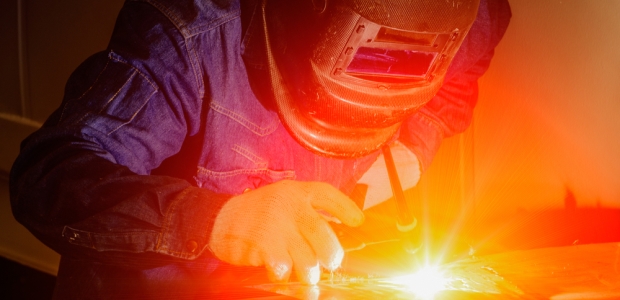
Keep An Eye on Welding PPE
The OSHA mandatory standard specifies both eye protection and protective clothing for welders.
- By Jerry Laws
- Apr 01, 2016
When researching personal protective equipment requirements for welders, OSHA's 29 CFR 1910.252(b)(2) is a good place to start. Unsurprisingly, it begins by specifying eye protection.
The standard states that welders' filter lenses must meet the test for transmission of radiant energy prescribed by the ANSI/ISEA Z87.1 standard, the American National Standard for Occupational and Educational Personal Eye and Face Protection Devices. ANSI/ISEA Z87.1-2015 is the current version of this standard and is available at www.safetyequipment.org.
The OSHA standard specifies that helmets or hand shields should be used during all arc welding or arc cutting operations (except for submerged arc welding) and that "goggles or other suitable eye protection" must be used during all gas welding or oxygen cutting operations. "Spectacles without side shields, with suitable filter lenses are permitted for use during gas welding operations on light work, for torch brazing or for inspection," it adds:
1910.252(b)(2)(i)(C)
All operators and attendants of resistance welding or resistance brazing equipment shall use transparent face shields or goggles, depending on the particular job, to protect their faces or eyes, as required.
1910.252(b)(2)(ii)(A)
Helmets and hand shields shall be made of a material which is an insulator for heat and electricity. Helmets, shields and goggles shall be not readily flammable and shall be capable of withstanding sterilization.
1910.252(b)(2)(ii)(B)
Helmets and hand shields shall be arranged to protect the face, neck and ears from direct radiant energy from the arc.
1910.252(b)(2)(ii)(C)
Helmets shall be provided with filter plates and cover plates designed for easy removal.
1910.252(b)(2)(ii)(D)
All parts shall be constructed of a material which will not readily corrode or discolor the skin.
The mandatory standard also addresses protective clothing for welders in 1910.252(b)(3). It states that employees exposed to the hazards created by welding, cutting, or brazing operations "shall be protected by personal protective equipment in accordance with the requirements of 1910.132," the general OSHA PPE standard, and it adds that appropriate protective clothing required for any welding operation varies according to the size, nature, and location of the work to be performed.
The OSHA 1910.132 standard covers much of the full range of PPE—vision protection, head and face protection, protective apparel, and respiratory protection—and specifies that step one is a hazard assessment by the employer, with the following steps being PPE selection and worker training. Once trained, they should understand, at the least, when PPE is needed and what type(s) of PPE are necessary; how to put on the take off the PPE properly, adjust it, and wear it; the limitations of their PPE; proper care and maintenance of the PPE; and what the useful life of their PPE is how to dispose of it. Every employee is to "demonstrate an understanding" of this training before being allowed to perform a task requiring their use of PPE.
Welding Fume Concerns
OSHA recommends using local exhaust ventilation to prevent welders' exposure to welding fume, which can contain a bevy of hazardous substances—metals and also shielding and process gases. A 2013 fact sheet1 on welding fume from OSHA notes that a number of factors affect workers’ exposure to welding fume, including the type of welding process being done, base metal and filler metals being used, location, work practices, use of ventilation, and air movement.
Respiratory protection may be required if ventilation measures and work practices do not reduce potential exposures to safe levels, according to this fact sheet, which discusses the health effects of breathing welding fumes.
These health effects include eye, nose, and throat irritation; possible lung damage; various types of cancer; kidney and nervous system damage; and suffocation when oxygen-displacing gases are involved in welding in confined or enclosed spaces.
Fire Protection
The American Welding Society offers 41 safety and health fact sheets at http://www.aws.org/standards/page/safety-health-fact-sheets, including one devoted to fire and explosion prevention. This Fact Sheet No. 6 warns that sparks, spatter, and molten metal can travel up to 35 feet or more from the welder's work area. Welding and cutting in spaces that contain flammable gases, vapors, liquids, or dusts can cause an explosion, it states.
The fact sheet explains how to mitigate the fire risks by removing combustible materials within a 35-foot radius around the work area, obtaining a hot work permit when required, providing adequate ventilation in work areas in order to prevent flammable gas, vapor, or dust accumulations, and thoroughly checking the area for any evidence of fire after the welding or cutting operation is completed.
Appropriate fire extinguishing equipment should always be nearby, and personnel engaged in welding should know how to use it, the fact sheet explains.
Reference
1. https://www.osha.gov/Publications/OSHA_FS-3647_Welding.pdf
About the Author
Jerry Laws is Editor of Occupational Health & Safety magazine, which is owned by 1105 Media Inc.